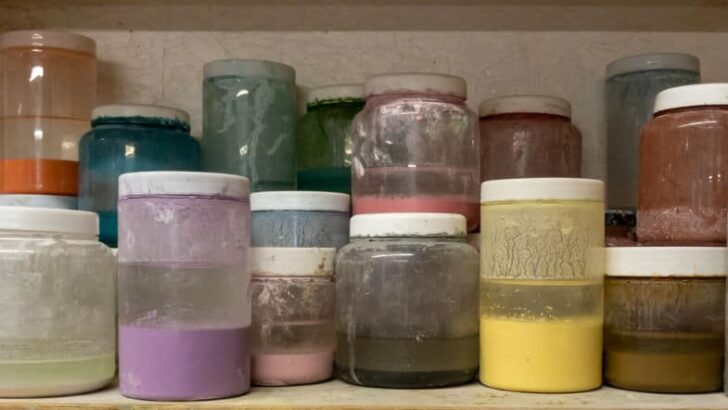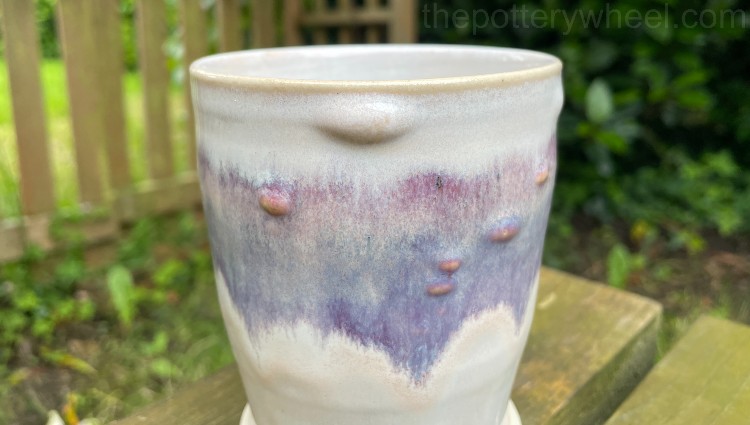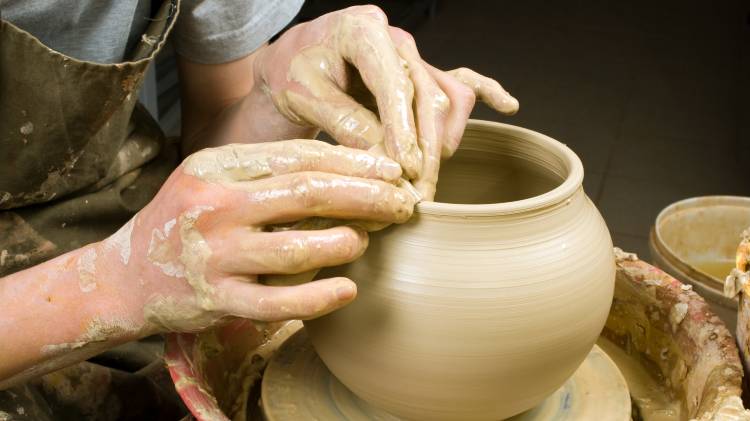Learning to use glaze is an exciting and creative time. Glaze can create an unending number of effects and finishes. However, you may have come across alarming information that glaze can be toxic. You may be handling glaze in its powdered form or a liquid state. Either way, it’s important to ask the question, is pottery glaze toxic?
As long as you are careful, pottery glaze does not pose a danger. Certain glazes contain materials that are toxic. However, provided these are handled with caution, they can be safe to use. Care needs to be taken not to inhale powdered glaze and fumes that come from glaze firing.
Is Pottery Glaze Toxic and Why Is This an Issue?
Once upon a time, Europe loved lead. From painting to face powder to pottery, lead was used in a huge range of artistic endeavors.
Of course, now we look cringe at the idea of lead in makeup. But originally the long-term dangers to health were not known. It wasn’t until much later that people discovered and understood the implications of lead poisoning.
We are now much more conscious of the effects of exposure to different chemicals and compounds. As a result, there has been growing concern over the toxicity of certain glazes.
For a long time, lead-based glazing was common. If putting on some lead face powder could make ladies at court sick, imagine what ingesting it by eating and drinking from lead-glazed plates and cups must’ve done.
Lead as well as cadmium is among the most common toxicity issues when it comes to pottery glazing.
Is Older Pottery Glaze Toxic? – Dealing with Old Pottery
Aesthetically, antique pottery can be absolutely gorgeous. From a historical standpoint, it represents a unique window into folk art and interior decorating traditions.
From a cooking standpoint, Crock-Pots can be incredibly flavorful. But from a health standpoint, it can be a minefield, as much old pottery that used lead glazing can still be toxic.
Old pottery and ceramics often make use of earthenware, which is a porous type of clay that needs to be blazed before it can hold food or liquid (source). If you use these ceramics for show, they should still be safe as long as you prevent children from touching them and putting their fingers in their mouths.
However, if you bake with them, they may be trouble. There is still a risk of lead poisoning, especially when paired with acidic foods and drinks as well as beverages such as coffee. That can be true with lead-glazed pottery used at high temperatures, as this can cause the lead to fuse with the pottery.
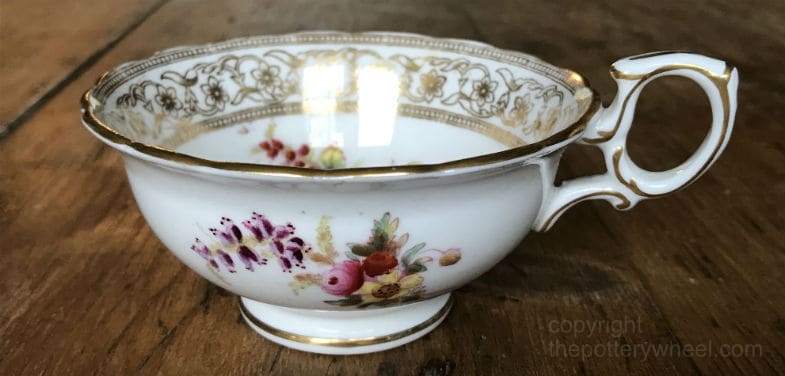
Those high temperatures and the pottery firing process really matter. If they are done improperly, glazing will not bond properly to the clay body. Instead, it sits on top of the clay surface and there is a danger that it can break off and mix in with food and drink. This can lead to you accidentally ingesting glaze. This is especially problematic if the glaze contains lead.
How Things Have Changed
Before you start panicking and throwing out your pottery glaze, you should know that things have changed considerably. The large majority of glazes do not contain lead. And when they do there is a legal requirement that they are labeled as such. Pottery traditions that once made use of lead glazing have switched to non-lead options.
Whenever old pottery and food are mentioned, it’s only a matter of time before Crock-Pots crock up. They are a favorite among cooks who love their classic look as well as the way they can trap flavor. Their antique nature can cause some concern over their glazing status. Thankfully, while the FDA has listed potentially contaminated products, Crock-Pots are not among them.
How to Avoid Toxic Glaze
All of that is well and good, but what about the pottery you want to make? How can you make sure that your glazing efforts won’t lead to toxicity and poisoning issues as well?
Steering clear of cadmium and lead is a big first step, and thankfully, it’s an easy one to do. As alluded to above, professional potters now mostly use non-lead-based glazing materials. There are plenty of such options out there, and at affordable prices as well.
Some glazes do contain lead, but as stated above, manufacturers are obliged to label them clearly. Ultimately, it’s up to the individual potter if they want to use lead-based glazes. But if you do, the use of this pottery needs to be decorative only. These pieces are not food safe.
It’s Not Just About Lead
However, lead is not the only potentially toxic ingredient. If you’re just starting out, it can be difficult to know which glazing types are potentially hazardous. You will, therefore, want to do your homework and make sure that any glazing you use does not contain other toxins such as cadmium. If you are asking the question ‘is pottery glaze toxic’, looking out for lead is not the only consideration.
In addition, other materials, such as barium, cobalt, nickel, and selenium can also be potentially toxic if they are present in large quantities in your glazing. However, as long as they are only present in very small quantities, they should be fine.
Another question you’ll want to ask is what type of pottery work you are doing. If you are using clay as part of a school project with students, rest assured – all glazes sold to K – 12 schools must rank as AP nontoxic.
This is done specifically to ensure that a child who accidentally ingests the glazing does not get lead poisoning or any other type of sickness that may arise from potentially toxic glazing. You should, therefore, look for that AP-approved non-toxic sticker on any glazing you buy for school purposes.
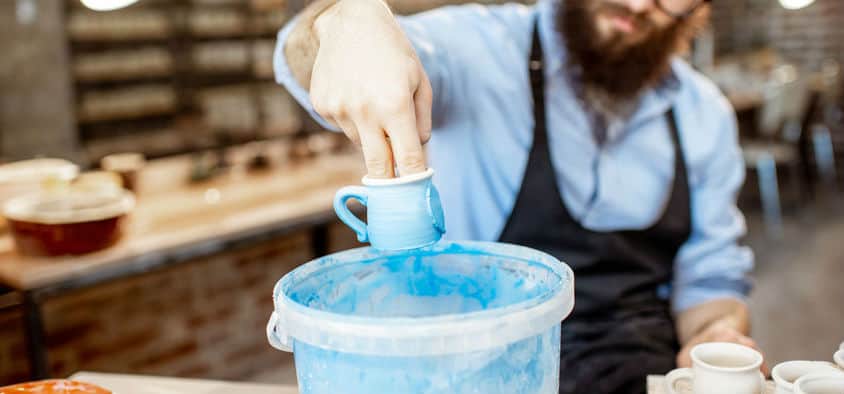
On the other hand, if you are purchasing glazing for your own arts and crafts work, either to sell them or simply make them for yourself or friends, you’ll be dealing with commercial glazing, and that requires closer scrutiny.
Most glazes are labeled as being either AP non-toxic or CL Cautions Required, the latter of which means that it contains materials that may carry health concerns. In this context, “nontoxic” only refers to cadmium and lead.
How to Glaze Your Pottery Safely
In addition to selecting a glaze that is non-toxic, it’s important to develop safe glazing practices too.
Applying Glaze Safely
No matter what type of glaze you are using, it’s important not to ingest it while working with it. You should, therefore, refrain from eating or drinking while working with clay.
Even if you don’t have food and drink around when you glaze, it’s important to wash your hands after glazing.
Even if you’re being careful, it’s easy to contaminate your food or drink with glaze or clay as you work.
Also, whether a glaze is labeled toxic or not, it’s important that they are not inhaled. For example, some glazes contain manganese. Whilst manganese may not be hazardous in some situations, it is problematic if you inhale it in its dry form. On the other hand, it is generally safe after it has been fired in the kiln.
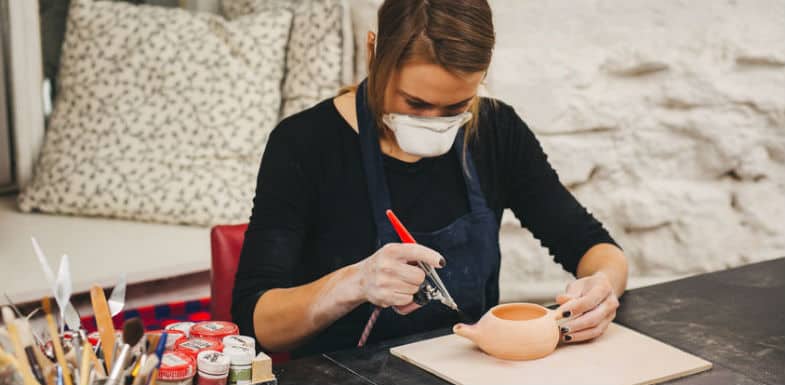
It’s therefore advisable to wear a dust mask when handling glaze in its powdered form. Additionally, you’re advised to work in a well-ventilated area. If you are airbrushing your glaze, it’s essential to wear a respirator.
In short, try to avoid glazes that contain lead. Any glaze that is labeled food-safe does not contain lead in it. If you do decide to use a lead-based glaze you can only use it for decorative purposes.
Firing Glaze Safely
When glaze is fired it can give off fumes that are noxious. For that reason, it’s important that the kiln room is well-ventilated. Ideally, the door to the kiln room should be left open, along with a window. This allows for the free circulation of air.
It’s worth noting that many manufacturers state that it’s not possible to say that a glaze is categorically food-safe. The reason for this is that whether a glaze is food-safe depends on how well it has been fired. There are factors outside the manufacturer’s control, like how the glaze has been used. These factors affect whether the glaze is food-safe or not.
Glazes That are Not Toxic but That Can be Irritants
Then there are materials that are not necessarily toxic but may be harmful. For example, some glazes can cause significant severe irritation (source). These include:
- Antimony
- Arsenic
- Soda ash
- Potassium carbonate
- Fluorspar
- Chromium
- Vanadium
- Nickel
- Alkaline feldspars
Avoid using these if possible. If they are a necessary part of the glaze, make sure you wear a mask and gloves. It’s also a good idea to cover your skin so that the ingredients don’t get absorbed through your skin.
Final Thoughts
So, is pottery glaze toxic? The short answer to this is that it varies. Some glazes do contain toxic substances. Others, though they are not toxic, can be irritants. And still, others are more or less inert. Either way, it’s a good idea to exercise caution when handling glaze. You can take certain basic safety precautions, which if observed should allow you to use glaze without problems.

